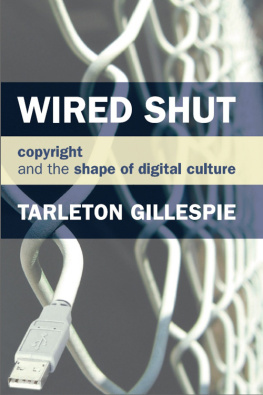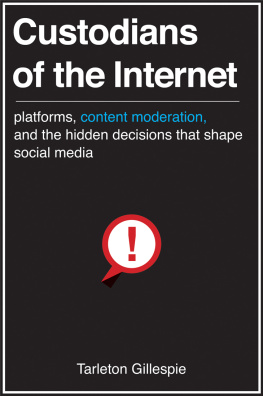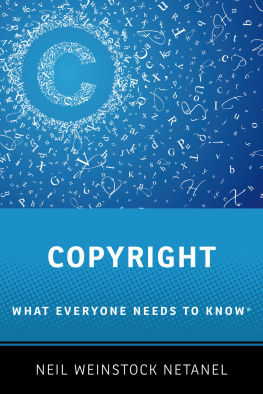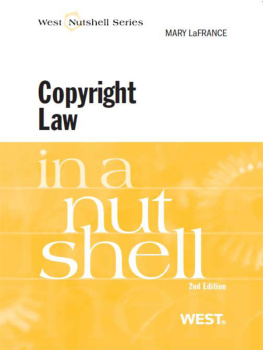Wired Shut
Wired Shut
Copyright and the Shape of Digital Culture
Tarleton Gillespie
The MIT Press
Cambridge, Massachusetts
London, England
2007 Massachusetts Institute of Technology
All rights reserved. No part of this book may be reproduced in any form by any electronic or mechanical means (including photocopying, recording, or information storage and retrieval) without permission in writing from the publisher.
MIT Press books may be purchased at special quantity discounts for business or sales promotional use. For information, please email or write to Special Sales Department, The MIT Press, 55 Hayward Street, Cambridge, MA 02142.
This book was set in Stone Sans and Stone Serif by SNP Bestset Typesetter Ltd., Hong Kong. Printed and bound in the United States of America.
Library of Congress CataloginginPublication Data
Gillespie, Tarleton.
Wired shut : copyright and the shape of digital culture / Tarleton Gillespie.
p. cm.
Includes bibliographical references and index.
ISBN13: 9780262072823 (hardcover : alk. paper)
1. CopyrightElectronic information resources. 2. Piracy (Copyright) I. Title.
K1447.15.G55 2007
346.04?82dc22
2006030129
10 9 8 7 6 5 4 3 2 1
d_r0
Contents
Acknowledgments
1 | The Technological Fix
2 | The Copyright Balance and the Weight of DRM
3 | The Speed Bump
4 | A Heroic Tale of Devilish Piracy and Glorious Progress, by Jack Valenti
5 | Why SDMI Failed
6 | Protecting DVDs: Locks, Licenses, and Laws
7 | Raising the Broadcast Flag
8 | Effective Frustration
9 | The Cultural Implications of Encryption
Notes
References
About the Author
Index
Acknowledgments
I owe a great debt, one that I suspect I cannot calculate nor ever repay, to all those who offered their help, support, and insights throughout the writing of this book. A special thanks for the guidance of Chandra Mukerji and Robert Horwitz. Many thanks to Geof Bowker, Dan Burk, John Caldwell, Julie Cohen, Shay David, Josh Greenberg, Jeff Hancock, Peter Hirtle, Steve Jackson, Joe Karaganis, Leah Lievrouw, Michael Lynch, Lev Manovich, Helen Nissenbaum, Trevor Pinch, Matt Ratto, Lucy Suchman, and Fred Turner for taking the time to read and improve the manuscript. Thanks to Doug Sery, Valerie Geary, Kathy Caruso, Amanda Nash, and Emily Gutheinz at the MIT Press, as well as the anonymous reviewers for their thorough and helpful critiques. A special thanks to Nat Sims for designing the cover of the book and to Alexa Weinstein for her meticulous proofreading. Thanks to all my colleagues in Communication at UCSD, and in Communication, Science & Technology Studies, and Information Science at Cornell, for providing the rich intellectual environments from which this work sprang. Thanks to the people at Claire de Lune Coffee Lounge in San Diego and at Wownet Cafe and Junas Cafe in Ithaca for their caffeine and hospitality. And for their endless support, patience, and encouragement, my eternal gratitude to my parents, my familyand most of all to Jenna and Jonas.
Portions of this book were assisted by a grant from the Digital Cultural Institutions Project of the Social Science Research Council, with funds provided by the Rockefeller Foundation. Thanks also to the participants of the Digital Cultural Institutions and the Future of Access: Social, Legal, and Technical Challenges workshop at the Center for Science, Technology, and Society, Santa Clara University, October 2123, 2004, for their advice. Thanks also to the Center for Internet and Society at the Stanford Law School for the support and community provided by its 20052007 fellowship award.
Pieces of this research, at various stages of completion, were presented at conferences hosted by the Association of Internet Researchers (AoIR) and the Society for the Social Study of Science (4S), and as colloquia for the department of Science & Technology Studies at Rensselaer Polytechnic Institute, the department of Information Science at Northeastern University, the Information Society Project at Yale School of Law, and the Center for Internet and Society at Stanford Law School. Many thanks to the participants and audiences in all of those places for their attention, questions, and suggestions.
A version of .
A version of appeared as Designed to Effectively Frustrate: Copyright, Technology, and the Agency of Users, New Media and Society
8.4 (Aug. 2006): 651-669. It appears here with the permission of New Media and Society and Sage Publications.
A portion of appeared as Autonomy and Morality in DRM and Anti-Circumvention Law, Triple C: Cognition, Communication, Cooperation (2006), co-authored with Dan Burk. It appears here with the permission of Triple C, and with gratitude to Dan Burk.
A portion of will also appear as Price Discrimination, Regional Coding, and the Shape of the Digital Commodity, in Joe Karaganis and Natalie Jeremijenko, eds., Structures of Participation in Digital Culture (forthcoming, 2007).
1 | The Technological Fix
It seems like ages, although its been only a few short decades, since Alvin Weinberg posed the question, In view of the simplicity of technological engineering and the complexity of social engineering, to what extent can social problems be circumvented by reducing them to technological problems? Can we identify Quick Technological Fixes for profound and almost infinitely complicated social problems, fixes that are within the grasp of modern technology, and which would either eliminate the original social problem without requiring a change in the individuals social attitudes, or would so alter the problem as to make its resolution more feasible? We may be a bit amused, or perhaps a little shocked, by the navet of Weinbergs tragically optimistic questionespecially when we discover that his answer was a qualified yes pointing to, of all things, the hydrogen bomb as a successful technological fix for the social problem of war.
We can only hope well never again be so nave as to think we can somehow simply and justly resolve social problems with technologies, or so oblivious to their own intricate consequences when we try to do so anyway. But its a surprisingly elusive lesson. We still search for, and long for, such technological fixeseven as we give perfunctory lip service to how they are only stopgap measures or technological add-ons to social policies. As Carolyn Marvin wrote, People often imagine that, like Michelangelo chipping away at the block of marble, new technologies will make the world more nearly what it was meant to be all along. And the social problems we hope to resolve are as intractable as when Weinberg wrote. We hope trigger locks will reduce violent crime, cameras and facial recognition algorithms will ensure privacy and public safety, smart ID cards will squelch terrorism, the V-chip will protect children from images of sex and violence. These technologies hold out the promise of attaining progressive social goals, and of doing so effectively, fairly, and without discriminationa promise built upon the persistent sense that technologies exist outside the frailty, inertia, and selfishness of human politics.
This faith in technology as an inherently progressive force is a powerful Western paradigm wrapped tightly into the ethos of American culture. Yet it is an illusion. By itself, technology can never solve the problems its proponents aspire to solve. Imagining that new technology will rescue us from our persistent social ills allows us to momentarily forego the much harder questions: What are the social bases for the problem, how do they work, and why does the problem persist? What forces shaped this technology, what is it supposed to accomplish, and what does it demand of us in order to work? Technological fixes also help abrogate the responsibility of both the people involved in the problem and the designers of the technology themselves. Perhaps this sense of determinism is appealingdont we want the new dishwasher to scrub our cares away? Rob Kling notes that these Utopian visions resonate with the public imagination because their causal simplicity gives them great clarity and makes them easy to grasp, to enjoy or to abhor. They can resonate with our dreams and nightmares. And in a culture bound tightly to an economic and ideological commitment to a neverending flow of new commodities, planned obsolescence, and the luxurious promises of advertising, the claim that technologies will fix what ails us is an all-too-familiar marketing ploy.
Next page









